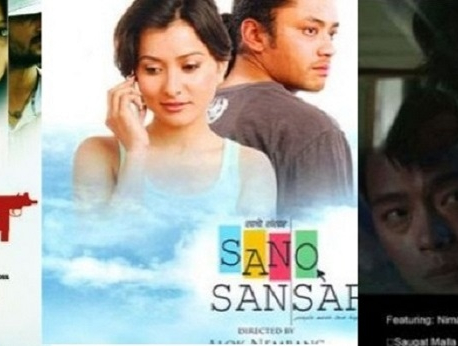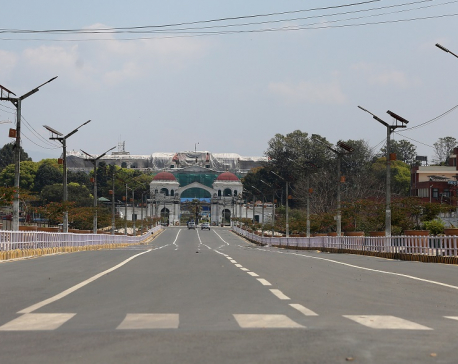
OR
_20200803095143.jpg)
As the health crisis resulting from the pandemic gets more and more serious, who will come to the rescue of the most vulnerable lot?
The lockdown had just started.
That afternoon, a raggedly old man with a heavy load of corn stacks approached me on a desolate road in our neighbourhood, with his face—and perhaps his whole body—running a sweat.
The poor guy had lost his way. He was to deliver the load to a cowshed at Vanasthali, but had landed at Triveni Chowk instead.
I tried to put myself in his shoes, only to find that he was barefoot. The responsibility of running a family rested heavily on his head and shoulders growing frail day by day.
We offered him water and inquired whether he was hungry. He wanted neither water nor snacks. All he wanted was to find his way to the cowshed and be with his family after getting the heavy load off his back and getting his wage.
What surprised me was that this guy did not even have a mobile phone. If he had, he would have called up the cowshed owner and found his way relatively easily, even if he were not that savvy to read the Google map and find the destination.
The lack of even a cellphone set, to me, was an indication of economic hardships that this man was facing.
Without a cellphone and a sense of direction, this individual must have gone through a lot of hard times before reaching his destination.
A few days later, among many visitors, a young man came knocking at our gate. Apparently, this youth had lost his job with the factory employing him closed due to the coronavirus pandemic and the lockdown imposed to control it. We could offer him precious little—some money and rice—fearing hard times ahead for ourselves if the situation got worse. Other families in the neighbourhood did not even respond to the hungry youth’s distress calls.
The images of the old man and the youth still haunt me whenever I ponder over this raging pandemic that seems to be spreading quite fast in Nepal as well.
Media reports suggest that we are in the throes of community spread of the deadly virus, at a time when the government has lifted the lockdown due, mainly, to pressure from the public and the compulsion to raise taxes to run the affairs of a dysfunctional state reeling under corruption and mal-governance.
Recent reports, citing a study of wastewater samples collected from different parts of the Kathmandu Valley, have also pointed at detection of coronavirus in the samples. What does this point at if not the community spread of the virus in the valley? Experts know better.
Also, reports dated July 30 state, citing the Ministry of Health and Population (MoHP), that the day saw detection of 30 coronavirus cases in the Valley.
Another report from Banke district also points at community transmission of the virus, with 27 persons testing positive on July 30 alone.
In Nepal, as of July 30, 2020, 52 people have already died from coronavirus. As per the MoHP website, the number of PCR tests conducted thus far stands at 3,64,648, RDT tests at 3,12,402, PCR negative cases 3,45,1011 (out of the total PCR tests), PCR positive cases at 19,547, the number of people in quarantines at 13,201, the number of those in isolation at 5,247 and the number of recovered patients at 14,248.
Right across the border down south, India offers a cautionary tale amid the pandemic. There, as per mygov.in/covid-19 (accessed on July 30), the total number of coronavirus deaths stands at 34,968, total cases at a whopping 15,83,792 and total samples tested up to July 29 at 1,81,90,382.
A relatively hassles-free movement of people into Nepal from the emerging global coronavirus hotspot makes Nepal particularly vulnerable to a serious humanitarian crisis resulting from the pandemic.
Such is the situation that even the sole global superpower, the United States, appears helpless when it comes to controlling/containing the virus.
According to a Huffington Post report, one person in the United States died about every minute from COVID-19 on Wednesday (July 30) as the national death toll surpassed 1,50,000, the highest in the world.
As worldwide deaths due to the virus reach close to seven lakhs as of this writing and uncertainty persists as to what shape the pandemic will take, the global economy is already on sickbed and this situation will worsen further before it gets any better.
According to the World Bank forecasts (June, 2020), the global economy will shrink by 5.2 percent this year. Per the World Bank, that would represent the deepest recession since the Second World War, with the largest fraction of economies experiencing decline in per capita income since 1870.
Economic activity among advanced economies is anticipated to shrink by seven percent in 2020 as domestic demand and supply have been severely disrupted. Emerging market and developing economies (EMDEs) are expected to shrink by 2.5 percent this year, the first contraction as a group in at least sixty years.
Per capita incomes are expected to decline by 3.6 percent, which will tip millions of people into extreme poverty this year.
With schools and institutes of higher learning closed due to the pandemic, human capital development is bound to suffer as the pandemic rages on.
Per the World Bank, in countries with widespread informality, the health and economic consequences of the pandemic are likely to be worse.
(This applies to Nepal too, perhaps. What say you, experts?)
Per the World Bank, economy activity in the South Asia region is projected to contract by 2.7 percent as pandemic mitigation measures hinder consumption and services activity and as uncertainty about thecourse of the pandemic chills private investment.
At home, as the health crisis resulting from the pandemic gets more and more serious and as the government shows inclinations to raise taxes further and further instead of slashing pay and perks for VIPs, VVIPs (of which there’s no dearth in Nepal) and cutting down administrative expenses, who will come to the rescue of the most vulnerable lot, like the old man and the hungry youth?
Above all, will the Nepali state even bother to think about them, let alone reach out to them, rescue them and provide them with means of sustenance, even if they are in no position to pay taxes at present?
You May Like This

Talking movies during the coronavirus pandemic
Recent weeks have seen a flurry of news items and interviews about the state of the Nepali movie industry in... Read More...

The government decides to move ahead with development works despite lockdown
KATHMANDU, May 7: The government has decided to continue with the development construction works although it has extended the lockdown... Read More...

Comedy of errors
Prime Minister’s office sometimes make such egregious mistakes that people wonder who actually run his office, if those who are... Read More...







Just In
- NRB to provide collateral-free loans to foreign employment seekers
- NEB to publish Grade 12 results next week
- Body handover begins; Relatives remain dissatisfied with insurance, compensation amount
- NC defers its plan to join Koshi govt
- NRB to review microfinance loan interest rate
- 134 dead in floods and landslides since onset of monsoon this year
- Mahakali Irrigation Project sees only 22 percent physical progress in 18 years
- Singapore now holds world's most powerful passport; Nepal stays at 98th












Leave A Comment